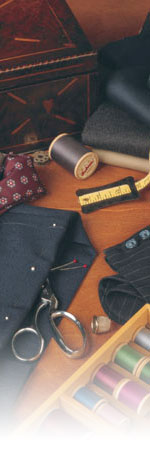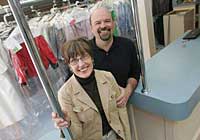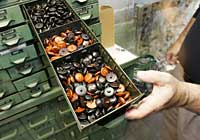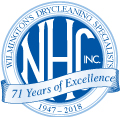 |
||||||||
|
|||||||||
After 60 Years, Details are Still the Focus Family-owned Penny Hill dry-cleaning business noted for By BETH MILLER, The News Journal PENNY HILL — Where do you take a pair of 19th-century silk dresses to be cleaned? And how do you get the wrinkles out of acres of fabric? When Linda Eaton, curator of textiles for Winterthur Museum, faces such challenges, she calls North Hills Cleaners in Penny Hill. The cleaners brought the dulled silk dresses back to a light-reflecting sheen, she said, and washed and pressed the quilt backings now protecting Winterthur’s “Quilts In The Material World” exhibit. “Because North Hills is a hands-on family firm and very experienced, they’ve been willing to do special things for our objects,” she said.
“My dad always said, ‘If you do the job right, you’ll get the work,’ ” Mark Peters said. North Hills is not for bargain hunters. While some cleaners charge $1.25 to launder and press a business shirt, North Hills charges $2.50. But, Peters said, the business uses high-end detergents that leave fabrics with a “soft hand,” high-end equipment and a process that protects the life span of garments. The staff has persnickety inspection methods and doesn’t cut corners. “We cater to those looking for quality,” he said. The times have changed since Peters’ dad and uncle opened the business in 1947, and the cleaning process has changed, too.
The cold-storage unit holds an assortment of furs and leathers — in an optimal 58-degree, 50 percent humidity environment. But Peters said demand for fur storage has declined, perhaps reflecting society’s changing views on fur coats. The vault used to hold 1,000 furs in the 1950s, he said. It now has more like 200 to 300. What hasn’t changed is the continuing challenge of removing assorted spots and stains from people’s clothes. Certified dry cleaner/spotter Kevin Murphy of Bellefonte last week worked with a pair of beige silk walking shorts whose owner had spilled red wine on them. It was a challenging case. “Wine and silk do not mix,” Murphy said. But by the time he got done, it was impossible to tell they had ever done so. A high-pressure, 700-gallon, three-pass boiler produces steam for an assortment of machines. Some of the steam is drier, some more moist — depending on the job for which it is intended. Silk presses, puff irons, utility presses and detail machines keep wrinkles from leaving the premises. And long cardboard tubes are ready to keep tablecloths crease-free.
Detail work is crucial for this clientele and for another group Eaton sends North Hills’ way. Every year, Peters hosts graduate students from the University of Delaware’s art conservation program, offered in partnership with Winterthur. “Solvent-based cleaning, using a solvent other than water, is a very important part of cleaning historic objects,” she said. “So we take our graduate students to North Hills to show them behind the scenes how dry cleaners work. The people who own the firm are engaged and involved in running it, and because they specialize in high-end, special cleaning problems, they’re interested in those kinds of things.” The demonstration sometimes includes putting a piece of tissue paper into the pocket of a garment before dry-cleaning it, then extracting the paper — completely unchanged — from the pocket at the end of the process. Murphy said he has done the same thing by putting an aspirin pill in a pocket. It, too, emerges unscathed — as everyone hopes their dry-cleaning pile will. “I take my clothes there, too,” Eaton said. “I know too much about dry cleaning.” Contact Beth Miller at 324-2784 or . |






